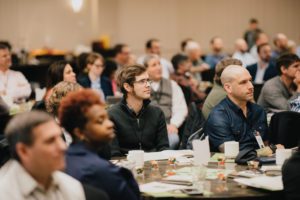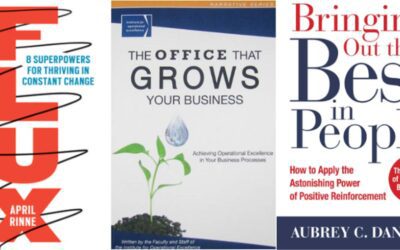The 2018 Oregon manufacturers’ Summit has officially wrapped, and our fifth year was a great success. Here are some takeaways from the summit from which all Oregon manufacturers can benefit.
Embrace Technology Strategically
“If you can maximize everything, so can your competitors. What is your distinguishing mark?” — Steve Brown at the Oregon manufacturers’ Summit 2018
 During his opening keynote, Steve Brown taught us about the power of automation and technology, as well as what we should do with that power. Many manufacturers are unsure how technology like Artificial intelligence, Internet of Things and Autonomous Machines can help their businesses without large upfront capital investments. As these technologies grow in influence manufacturers don’t want to be left behind, but struggle to embrace this future in a way that makes sense for a small or mid-sized company. According to Steve, manufacturers looking to understand and embrace technology should ask a few simple questions.
During his opening keynote, Steve Brown taught us about the power of automation and technology, as well as what we should do with that power. Many manufacturers are unsure how technology like Artificial intelligence, Internet of Things and Autonomous Machines can help their businesses without large upfront capital investments. As these technologies grow in influence manufacturers don’t want to be left behind, but struggle to embrace this future in a way that makes sense for a small or mid-sized company. According to Steve, manufacturers looking to understand and embrace technology should ask a few simple questions.
What is the future we want to build?
What is the future we want to avoid?
Steve shared many examples of how technology is influencing product development, deployment, content creation, and business or customer service models. Technologies are changing industries like farming, manufacturing, retail, and transportation/logistics as well as customer service.
Attendees were encouraged to take a long, hard look at their businesses and decide what should be automated and what shouldn’t. In today’s world, everything can be automated, from order taking to production. When everything can be automated, your differentiator becomes your employees. Business leaders should ask themselves, where do my people shine, and where can technology enhance the work they’re already doing? For example, computers can analyze data much faster than humans, and can recognize patterns a person might miss. But it is up to the human to decide what to do with that data moving forward.
To create a technology strategy for your business, you need:
- Sensor and data strategy – Where can tracking enhance your workers’ flow and productivity?
- Frank labor assessment –Where do humans shine, and where can robots or automation eliminate repetitive work for them? Hint: humans are great at creativity and problem-solving. This isn’t about eliminating jobs or massive layoffis, its about placing people where their natural skills and abilities do the most good, and eliminating rote, dirty, dangerous or repitive task for them.
- Business process audit – What office or administrative duties would be enhanced by automation? As your business grows, can you tap into the power of technology to help scale? Are there workflows that can be eliminated or enhanced by introducing new tech tools?
- AI strategy and deployment – Where does this type of intelligence make sense, or where does the human add more value.
- Training strategy: How can you help your team adjust to these new tools, and use them to enhance your existing training programs? i.e. augmented reality training for various tasks
- Upstream/downstream strategy
We’re going digital, like it or not so embracing technology is critical to success. This is a time of change for our industry and we can embrace it as a manufacturing community. Let’s work together to make a technology plan, stick to it, and build the world we want to see.
“The traditional mindset says you should use technology to reduce cost and maximize productivity. That’s inappropriate moving forward. A productive mindset is to use technology to maximize humanity and maximize scale” – Steve Brown
Innovation is an Art and a Science
“The right mentality is, ‘I don’t know’ – this sets you up for learning and growth” Geoff Gilmore at Oregon Manufacturers Summit 2018
 As manufacturers, it’s easy to discount innovation as something for ‘other people’ or too big to tackle in a small company. Geoff reminded attendees that innovation is simply putting elements that already exist into new formats. For example, Uber wasn’t new: it combined existing electronic payments technology, electronic customer feedback, and dispatch. The disruption created a higher market cap in much shorter time than more traditional companies.
As manufacturers, it’s easy to discount innovation as something for ‘other people’ or too big to tackle in a small company. Geoff reminded attendees that innovation is simply putting elements that already exist into new formats. For example, Uber wasn’t new: it combined existing electronic payments technology, electronic customer feedback, and dispatch. The disruption created a higher market cap in much shorter time than more traditional companies.
The art of innovation is in leadership
True leadership makes something happen that would not otherwise happen. Innovations don’t happen by themselves. A good leader doesn’t let things get too comfortable. He or she knows that although they can’t just tell people to innovate, they need to push for innovation so their company can thrive. To do this, a leader must be confused right along with employees to arrive at a breakthrough. Along the way to innovation, leaders and employees encounter four rooms of change – moving from comfort to denial to confusion and finally, to a breakthrough. The leader’s job is to help navigate through these areas of change, enabling employees to learn quickly from failure, suspend judgment (and stop voting) and celebrate success.
The science of innovation lies in design thinking
Project management thinking does not encourage breakthroughs. It simply doesn’t work. Instead, use design thinking to maximize creativity. There are many brainstorming tools out there – find one that works for you and your team and the direction you want to go. Fail fast – don’t be afraid to work quickly with paper mockups and rapid prototyping. Learn from your failures by celebrating them. Help your company to move toward conscious competence by building creative practices into your daily activities.
Catch up on media coverage of the Summit below.
Don’t Fear Robots, Fear Irrelevance
Aaron Fox, OMEP President, shared his thoughts about the need to adopt and embrace technology to survive. Click the link above to read the article in the Portland Business Journal.
Robots Strut Their Stuff In Tigard
Craig Tomita of Universal Robots discussed ‘Co-Bots’ or Collaborative Robotics at the 2018 Summit. Safe to work alongside humans, these flexible robots can be an asset to manufacturers. You can read more in this article from The Tigard Times
Thank you to all who attended the Oregon manufacturers’ summit. We can’t wait to celebrate again with you next year. Thanks again to KeyBank, Moss Adams, IT Assurance, Energy Trust and Schwabe Williamson and Wyatt for their sponsorship.



